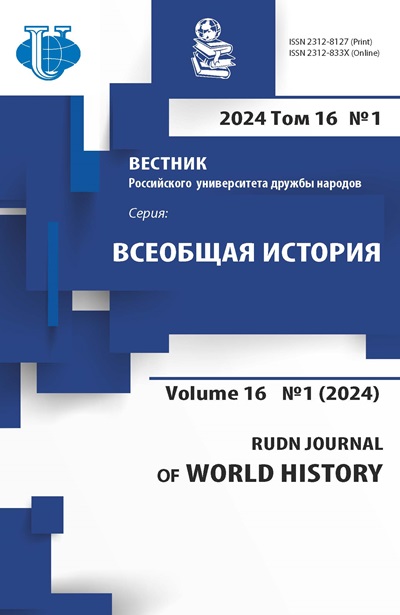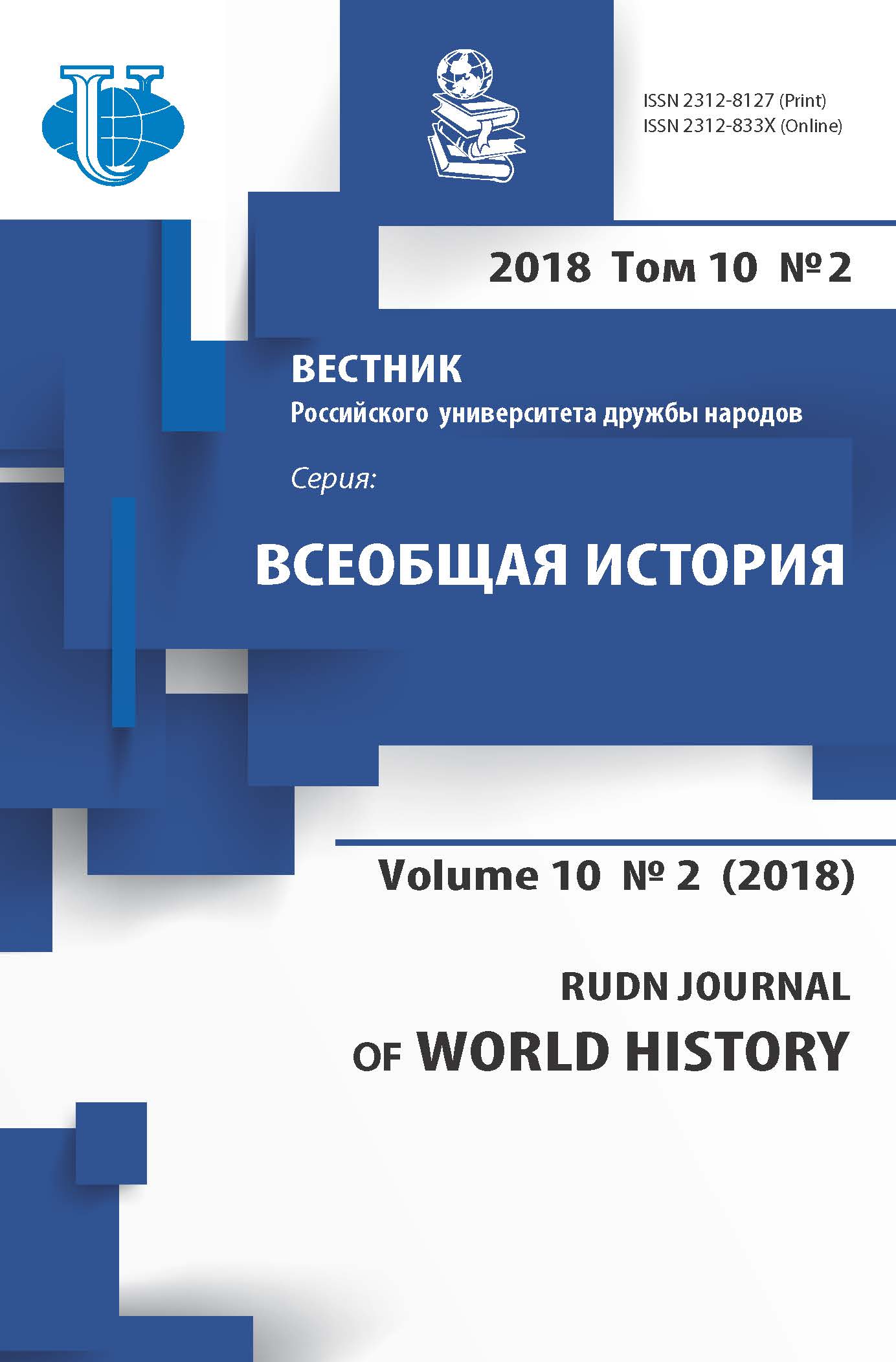Vol 10, No 2 (2018)
- Year: 2018
- Articles: 10
- URL: https://journals.rudn.ru/world-history/issue/view/1110
- DOI: https://doi.org/10.22363/2312-8127-2018-10-2
Full Issue
Dialogue of civilizations
KARAKORAM HIMALAYAS AND CENTRAL ASIA. THE BUDDHIST CONNECTION
Abstract
The Karakoram-Himalayan region is the cradle from where ancient Indian culture including Buddhism spread to different directions in Central Asia, East Asia and South East Asia. Gilgit, Chilas, Chitral, Baltistan, Ladakh, Zanskar and other frontier areas have been important mileposts on the famous Silk Route. Buddhist savants from India contributed to the spread of Buddhism in Central Asia and East Asia. One of the eminent scholars was Kumarajiva (344-413 AD) who broke political, geographical, cultural and linguistic barriers for propagation of Buddhism. Hieun Tsiang mentions four important centres of Buddhism in Central Asia - Shan-shan (Kroraina), Khotan, Kucha and Turfan. Kashmir played an important role in introducing Buddhism to Khotan, which in turn played a key role in the transmission of Buddhism to China. Several important places on the Silk Route system such as Kucha, Balkh, Bamiyan, Khotan, Kashgar etc. developed into important centres of Buddhism when parts of Central Asia and north-western India were integrated into a single kingdom under the Kushans.)
 109-125
109-125


TIBETAN RELATIONSHIP “CHO-YON” IN QIN SOURCES MID. XVII - END XVIII CENTURIES
Abstract
In the relations between Tibet and the Qing Empire an important place belongs to the traditional spiritual-patronal principle of “Choi-yon”, according to which the supreme lama of Tibet was considered as the religious counselor and mentor of the Emperor. The Emperor in his turn patronized the teachings of the Gelug school and played the role of a “charity”. Neither Tibetan leader nor Qing’s was in priority. After the Dalai Lama V’s visit to the court of the Emperor Shunzhi in 1652, on the basis of “Choi-yon” there was established a religious-political alliance, which existed until the fall of the Qing Empire in 1911. Nevertheless, in the period from the middle of the 17th century to the end of the 18th century we can trace the changes of interpretation of “Choi-yon”, and, first of all, for the status of the Dalai Lama. The Qianlong Emperor in his treatise “Lamasho” (1792) proclaimed domination of the Emperor’s authority before the spiritual guidance of the Lama.
 126-134
126-134


CULTURAL DIPLOMACY IN CURRENT INTERNATIONAL RELATIONS (ON THE EXAMPLE OF RUSSIA AND CHINA)
Abstract
The article considers the concept of cultural diplomacy and mechanisms of its implementation on the example of Russia and China. Many Russian and foreign researchers emphasize connection between the cultural diplomacy and the public diplomacy. According to them, the cultural diplomacy is a basis of the public diplomacy, which manifests itself in maintaining and developing contacts with other nations and peoples in the fields of culture, science and education. The objective of the public diplomacy is to create a positive image of the country abroad. The author gives as an example the culture diplomacy of Russia and China, due to both countries successfully promote Russian and Chinese languages, their culture and traditions.
 135-144
135-144


THE CONCEPT OF “INTERRACIAL CONTRADICTION” IN CHINA-AFRICA RELATIONS: INTERPRETATION AND REALITY
Abstract
The article deals with the problems of everyday interaction between the Chinese and the Africans, interpreted in historiography and media as interracial contradictions. The article analyzes several headline making conflicts in everyday life provoked by the intensification of China and Africa bilateral relations (1962-2017), the historical context of the cases and ideological attitudes. Based on that data the conclusion is made, that the concept of “interracial contradictions” covers up the whole complex of social problems of Chinese society (social and wealth inequality and polarization of the population, lack of freedom of speech, illegal immigration, etc.), which often not directly related to the interaction between the Chinese and the Africans.
 145-154
145-154


UKRAINE AND MOLDOVA IN THE PRC REGIONAL POLICY
Abstract
The rapid entry of the People’s Republic of China into the number of the most influential actors in the world political arena attracts close attention and causes interest of many politicians, researchers, scientists and the general public. China is currently a fast-growing state that has steadily demonstrated rapid growth of its economic potential in recent decades. That certainly provides opportunities for development of the political empowerment. China’s success in international affair is largely the consequence of its active regional policy. After the collapse of the Union of Soviet Socialist Republics on 26 December 1991, China was one of the first countries to recognize the independence of 15 new states. In 1991 and 1992 it established diplomatic relations with each of them. The PRC is at present pursuing a multidirectional policy towards all the CIS member states, in particular regarding Ukraine and the Republic of Moldova. In this article the author examines the role of Ukraine and Moldova in the PRC regional policy. Based on the results of the analysis, it is concluded that the PRC attaches importance to Ukraine and Moldova in terms of economy and geopolitics.
 155-167
155-167


Archaeological studies
INFLUENCE OF ETHNOCULTURAL CONTACTS WITH THE POPULATION OF SOUTH SIBERIA ON THE APPEARANCE OF METALLOLITE PRODUCTION IN CHINA IN THE ANCIENT
Abstract
The article contains materials on the relationship between China and the peoples of Southern Siberia in antiquity and the Middle Ages. The periods of antiquity can be reconstructed on the basis of archaeological materials. These are scientific publications of archaeological research of the most important monuments, albums of finds, etc. In addition, in the article, reports on the survey and excavation of archaeological sites on the territory of Southern Siberia from the Scientific and Branch Archive of the Institute of Archeology of the RAS for 1945-1965 are given as sources, the data from which were used in the study. They contain information that bronze and iron on the territory of this region appeared much earlier than in China. Given the complex of data, the article proves the assumption that it was through the mediation of the peoples of Southern Siberia that bronze (in the 2nd millennium BC) and iron (in the 8th century BC) fall into the northern regions of China, and from there spread throughout its territory, acquiring specific features of manufacturing technology and design.
 168-180
168-180


Oriental Studies
THE HERITAGE OF IBN ARABI IN THE CONTEXT OF THE CULTURAL DIALOG PROBLEM
Abstract
Islamic thought is a synthesis of different cultural elements. It includes elements of both Iranian and antique heritage, but it’s foundation is the Quranic text that was not just a product of Arabic culture, it has become a basis for the genesis of the classical arabic literature, thought and art. This article will try to demonstrate the Quranic text influence on the Ibn Arabi’s diverse writings as well as the Iranian one.
 181-191
181-191


THE HISTORICAL CORRELATIONS OF EGYPT’S FOREIGN POLICY
Abstract
The article is dedicated to the historical correlations, which had great influence on the process of formation and realization of Egypt’s foreign policy. The author considers the geographical position and historical characteristics as the historical correlations, which could not be changed by the will of man. The significant influence on Egypt’s foreign policy had its colonial past and bilateral relations with the leading states: Great Britain, France, the Soviet Union and the United States. It is stressed that since the moment of establishment the Suez Canal has become one of the key factors determining the position of Egypt on the international arena. An important role in Egypt’s foreign policy priorities is dedicated to the resource allocation of the Nile river. The author states that the great historical heritage and the advantageous geographical location allowed Egypt to take a leading position in international tourism sphere.
 192-200
192-200


Youngs scholars reports
THE PHENOMENON OF NEW WARS: CHANGING NATURE AND VIOLENCE DIPLOMACY
Abstract
 201-206
201-206


Reviews
REVIEW OF THE BOOK YUVAL NOAH HARARI “SAPIENS: A BRIEF HISTORY OF HUMANITY”. M., SINBAD, 2018
 207-211
207-211
















